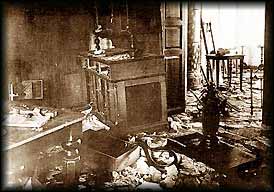|
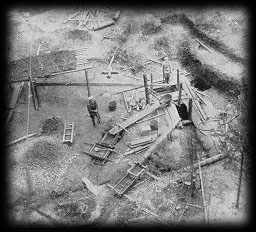
Pits mine during
investigations
|
In October, General Gajda, commander of the west white army decided to
establish his headquarters in the house. In spite of judge Serguéiev's
protests, Ipatiev house was invested including former Romanov's sealed rooms
under.
Only the cellar room could been saved and still kept sealed. But,
on several occasions, General Gadja entered it to have his guests visit it. From this
moment, we can seriously doubt about the authenticity of the words found on cellar room
wall ! They could have been written during that period. On January 23, 1919,
judge Serguéiev was replaced by Sokolov by order
of General Ditherikhs. |
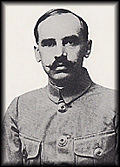
Nikolaï Sokolov
(1882 - 1924)
Nikolai Alexéïevitch Sokolov was born in
Mokshane, near Penza in 1882. After teaching right in Karkov, he became judge and
judicial investigator. After the revolution, he ran away not to serve the bolshevicks and
reached Omsk in Siberia. With other monarchist people, he took part in several attempts to
free the Romanov family without success. On February 7, 1919, he was officially appointed
by Koltchak admiral to investigate about the Romanovs'
murder. In 1920, at the white
army defeat, Sokolov, like a lot of people, left Russia and emigrated to France in the
small city of Salbris (41300 - Loir et Cher). Sick, without
resources, he had just time to finish to write the results of his investigation before
dying out on November 23, 1924, letting a 23 year old widow and two little children. The
same year, his book "Enquête judiciaire sur l'assassinat de la famille impériale
Russe" (In French) was published by Payot. In this book, he concluded that the whole
Romanov family has been murdered in Ipatiev house and their bodies had been entirely
destroyed. These conclusions had historic value until the bodies were discovered in
1989.
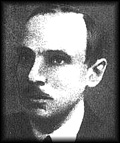
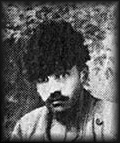

Others photos
and signature of
Nikolaï Sokolov |
Sokolov, after having examining
proofs found by his predecessor, started a very strict and complete investigation. He
questionned again a lot of witnesses, including former Ipatiev house red guards captured
by white army.
He also inspected the cellar room as well as pits mine in forest.
During this investigation in forest, he even discovered the place where the truck of
Yurovsky's men had stalled (You can see the photo on page 225 of his book) but he did not
think that Yurovsky could have hidden bodies under the wood planks
!
|
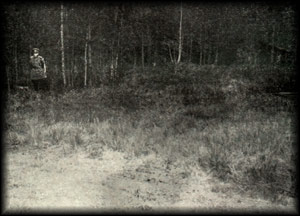
Sokolov on the
place where Romanov
remains will be found in 1979 ! |
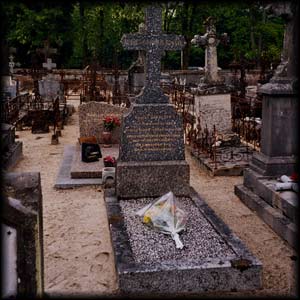
Sokolov's grave in Salbris
cemetery
(France - Loir et Cher)
 - Detail
of text - Detail
of text

|
As a conclusion, Sokolov's investigation was perfect. His only error was to
consider that Yurovsky and his men had succeeded in completely burning the
11 bodies in only two days and two nights.
In fact, tests made afterwards to simulate similar bodies
destruction showed that it was not possible to get rid of so many bodies in
such short time.
At the end of the year 1919, Ekaterinburg was again under bolshevicks threat and Nikolai
Ipatiev tried to sell his house to the russo-czech trade room. Learning this, Koltchack
admiral, forbad the sale and rent Nicolas Ipatiev 6000 roubles his house for 6 months to
carry on investigations. But one month later, white army had left the city and bolshevicks
were back.
Sokolov, like a lot of people, was forced to leave Ekaterinburg
and Russia. |
He
emigrated to France in the small city of Salbris (Loir et Cher).
Here, he finished to write the conclusions of his investigations.
Without any financial resources, like other Russian emigrants, he
had to accept the inhabitants help. Sick, Sokolov died in 1924 of an heart attack, letting
a young widow and two children. He was buried on the village cemetery where his grave can still
be seen (photo above). His book ; "Enquête judiciaire sur l'assassinat de la
famille impériale Russe" (In French) was published by Payot shortly after his death.
This book is still considered as a reference on this subject. |
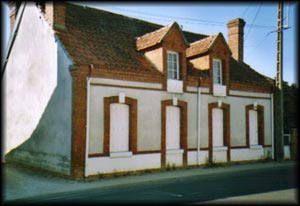
Sokolov's
former house in Salbris
(Picture kindly provided by
|
|
Almost as soon as the execution was
announced, rumors began spreading that some members of the imperial family had survived.
The two most famous stories involved the Czar's youngest
daughter, Anastasia, and Tsarevich Alexei. The most famous impostor was a woman named Anna
Anderson (Photo above), who convinced some of the Czar's relatives that she was
Anastasia. She claimed that she had not been killed in the cellar room and had been
rescued by one red guard.
In 1928, a German private detective, Martin Knopf, after
investigations had actually identified her as a Polish factory worker, Franziska
Schanzkowski. Recently, scientists used DNA testing to rule out Anderson's claims and to
confirm Knopf's investigations results
|
|

Anna Anderson. the
"most famous" Anastasia
|
But the
discovery of only 9 skeletons in Ekaterinburg woods, whereas 11 people had been murdered,
is still feeding theories that two children could have survived, despite Yurovsky's
testimony that these bodies have been burned and buried separately.
At the moment, they are still all over the world a lot of people
saying they had met Anastasia or Alexei who survived. For example, Vadim Petrov, Igor
Lyssenko and Georgi Egorov claim in their book, "The escape of Alexei, son of Czar
Nikolai II" that Alexis had not been killed and lived in the Russian city of
Chadrinsk under the name of Vassili Filatov...
A Canadian journalist, John Kendrick, has put the history of another
Alexei nammed Heino Tammet, who lived in Canada. You can
learn more about all this people on the pretenders
chapter of the site. |
|

I recommend you to read the comic strip 'Le
rossignol de Koursk' (In french) which is the volume II of the series 'Nuit Blanche',
realized by authors Yann and Neuray.
In this comic strip, the action takes place in Ekaterinbourg, just after the
murder of Romanovs.
You can cross in this comic strip Koltchac admiral, Sokolov judge and also
follow the hero in its visit
of Ipatiev House very well rebuilt.
Buy it on Amazon.fr
Buy it on
Fnac.com |
In Russia, Ipatiev
house remained for a long time unoccupied. In 1927, for the 10th anniversary
of the revolution, was opened in Ipatiev House a museum dedicated to the
revolution and about the murder of Romanov family. People could visit rooms
of the first floor but access to cellar room was not allowed because it was
used to store documents of the local soviet. Some postcards of the house
were even published. This museum was closed in 1932.
After 1945, Ipatiev
house was used on different ways: archives of the local party, museum of the
atheists local association, |

Tourists visiting cellar room
|
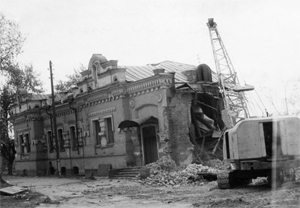
Destruction of Ipatiev house in July 1977
|
Ipatiev house was still forbiden to people but still visited by officials
and their friends. And the house carried on attracting people's curiosity:
For example, some furniture of the house had been
offered to a famous musician visiting Ekaterinburg. A professor from
Leningrad received a railing from the staircase as a souvenir.
The wall where the Romanovs were
murdered was even
sold to an English collector. And each 17 of July, flowers are put in front
of the house by people.
In 1974, the house was classified as historical
monument but the year after, dependences and floor rooms were destroyed.
|
Heavenly Hymns In The Ipatiev
House (Article)
The story was told to Archbishop Melchizedek, who had then been the hierarch
of katerinburg for many years.
At the time of the fall of the Soviet government in 1990, an old woman came
to his office. Although she was not a believer, she felt that she was going
to die soon and said that she had something she wanted to tell him.
After the death of the Czar and his family, the Ipatiev house had been
turned into the "Museum of the Workers' Revenge,"to commemorate the death of
the family. This woman, Anna, had been the night guard in the museum for
several decades, and although the rest of the house was open during the day
for visitors, the basement site of the family's murder was always kept
barred and locked. No one, including the guards, ever went down there. Anna
told the Archbishop that many times during her years of working there she
could hear beautiful singing and see light streaming from the basement door
when night fell. She said that the singing was as of many voices, and
definitely church music. She would often creep up to the door to listen but
was too frightened to go into the basement to look. She did not tell anyone,
since she knew that if she reported such things she would be dismissed and
possibly arrested. Archbishop Melchizedek asked Anna if she would sign an
affidavit attesting to the truth of her story, but she refused, saying that
she was too afraid of the KGB to sign anything that might get her in
trouble.
(Source: Orthodox Word, St. Herman of Alaska Brotherhood, Platina, Ca., Vol.
34.No.5 (202), Sept.-Oct., 1998., pp. 235-236).
|
In 1977,
it was decided to destroy Ipatiev house. This decision was taken in Moscow
by Michaïl Souslov, member of the politburo. This order was transmited to
the first secretary of the party of the region of Sverdlovsk, someone named
Boris Eltsine who was forced to execute it.
Then, in the night of 27 to 28 of July 1977,
Ipatiev house was distroyed.
|
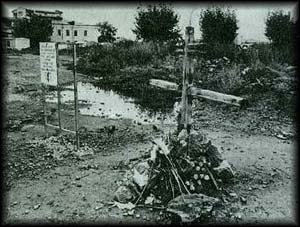
1990's : A Small little cross is
erected on cellar-room place
|
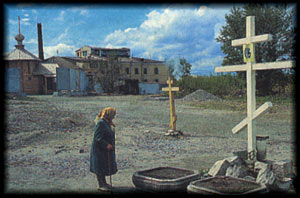
1991 : The
"eight ends" cross |
Officially, this destruction aimed at improving car traffic in this part of
the city but the real goal of this destruction was to put an end to this
house which symbolized people's interest in the Romanov tragic death.
Since this day, the site of Ipatiev house
remained vacant.
Although Romanov death
was a very sensitive subject,
a lot of people
went there secretly and put flowers. |
|
"This letter
is written to you by the Cossack Vladimir. I would like to tell you about a
manifestation (sign) that took place at the
moment when the cross was set up on the site of the Ipatiev house, where the
Czar and his family were killed.
On October 5, 1990, at about 11 a.m. - 12 noon, crushed stone was
brought in a truck. The weather turned gloomy. The whole
sky was filled with dark clouds, without any clear areas, and snow
fell sporadically.
|
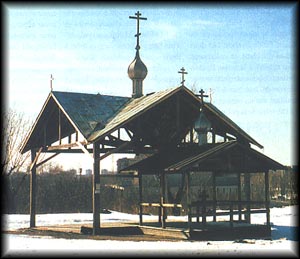
1998 : A small wodden chapen is
erected |
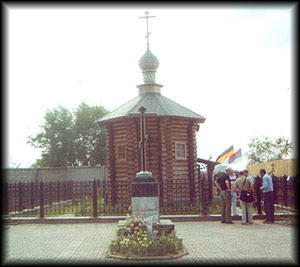
1999 :
A new wooden chapel has
replaced the old one. |
The cross was taken from the vehicle and placed on the ground and then set
in place.
One of the people present, Alexei by name, went off to one side to take
a look at how the cross had been set up, and whether it was leaning.
Suddenly Alexei said, 'Look up!' We all raised our heads, and sort of tremor
or fear passed through our bodies.
Above us - that is, directly
above the cross - the heavens parted and a ray of light fell upon the cross
from a round clear spot in the sky."
"The sun was not visible, and the opening in the clouds was rotating to
the right: and on the
earth, around the cross within a radius of 150 - 300 feet, there was a circle brightened by this ray of light from the heavens, and no snow was
falling. |
|
All this
continued for about thirty to forty minutes, while the cross was being set
in place and fixed with concrete, and then the opening in the clouds closed
up.
The light disappeared. Up to thirty people were present at the time.
(At that moment, all of them were unbelievers.)
When we asked a priest about this manifestation later, he replied that
this was obviously a sign. The majority of us came to believe in God
afterwards."
(Source: Russian
Herald, 1995, nos. 11-14. And reprinted in: Orthodox Word, St. Herman of
Alaska Brotherhood, Platina, Ca., Vol. 34, No.5 (202), Sept.- Oct., 1998.,
p.236).
|
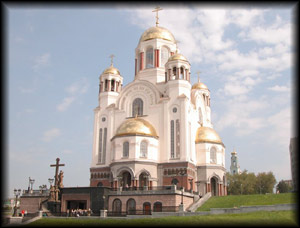
July, 16, 2003 : Opening of the
Cathedral on the blood,
built on the Ipatiev house place
|
|
Nota :
This article is especialy focused on the belonging of the rare relics
from Ipatiev house which still exist and can contain some repetitions
regarding other romanov-memorial.com website articles
>
Sokolov files relics
|
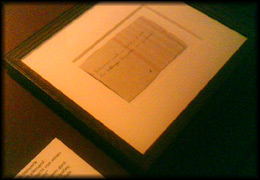
The wallpaper piece with the Hein Poem
during the TranSiberian exposure in Brussel
|
After the Romanov execution,
when Yekaterinburg was shortly occupied by the white army and during the
time of the investigations made by Koltchak Admiral team about the Romanov
killing, some house’s elements were picked up to inquiry purpose.
Then, on all known photos of the
cellar room taken during this period, and contrary to a tough legend, the
damages on the wall are not the result of the squadron firing but due to the
investigator work which collected some wall and floor pieces to extract
bullets.
Some of this piece, part of
the Sokolov files were saved from this time and still exist somewhere.
|
|
For example, the well known wallpaper piece with the Hein sentence
found in cellar room was exposed lately at Brussels during the TranSiberian
exposure between October 2005 and February 2006 and I had the opportunity to
see it at this occasion.
> Gibbs
relics
|
|
At this time,
Romanov’s relative, who escaped the Romanov tragic end collected also some
Imperial Family relics found on the woods or in the Ipatiev house like the
former Romanov children English teacher, Charles Sydney Gibbes, who recover
a large number of icons, some slightly charred, from the fireplaces and
dustbins, a pair of the tsar's felt boots.
He also took exercise books of Marie and Anastasia, a pencil
case and bell of the tsarevich and the chandelier which hung in the bedroom
shared by Grand Duchesses in Ipatiev house and bring it after to Great
Britain where he established in 1931 in Marston Street, Oxford.
Here, he had settled in his house a little chapel gathering
some of these Imperial Family relics. After his death in 1963, the house
became the property of his son, who sold the building and its contents to a
family who owned a great house called Luton Hoo, with a specialised
collection of Russian memorabilia, including that of the Imperial Family.
|

The chandelier from the Ipatiev House daughter room
hung in the Oxford house of Sydney Gibbes (picture from the book “the house
of special purpose by Trawin)
|
When Luton
Hoo was recently sold off for conversion to a
posh hotel , the Wernher Collection
was rehoused at Ranger's House, Greenwich, that is, except for the Gibbes
Romanov Collection which was retained by the Wernher Foundation…
> Other relics
After the end of
the civil war, Ipatiev house remained for a long time unoccupied. In 1927,
for the 10th anniversary of the revolution, was opened in the house a museum
dedicated to the revolution and about the murder of Romanov family. People
could visit rooms of the first floor but access to cellar room was not
allowed because it was used to store documents of the local soviet. Some
postcards of the house were even published. This museum was closed in 1932.
After 1945, Ipatiev house was used on different ways :
archives of the local party, museum of the atheist’s local association.
During all this years, the house; still forbidden to people, carried on
attracting curiosity due to his historical meaning and due to the dramatic
event which had took place here even at a time where the official sovietic
propaganda made this attraction forbidden even dangerous. In spite of this,
it was not rare that famous or official people welcomed in the city wanted
to visit it.
A lot of them ask, as a souvenir, to have their
photo taken in the cellar room. Even, some other required to carry some
elements of the house. For example, some furniture of the house had been
offered to a famous musician visiting Yekaterinburg. A professor from
Leningrad received a railing from the staircase as a souvenir. Some
paintings were also given to Lenin's friend Armand Hammer. Even the wall
where the Romanov were murdered was sold and could be still somewhere in
England now ! (Source: Gueli Riabov remembering and interview)
In the other hand, the place was gradually becoming a
pilgrimage place and each 17 of July; flowers were put in front of the house
by anonymous people in Czar Family remembering... In 1974, the house was
also classified as historical monument but the year after, dependences and
floor rooms were destroyed. In 1977, at end, it was decided to destroy
Ipatiev house. This decision was taken in Moscow by Michael Souslov, member
of the politburo. This order was transmitted to the first secretary of the
party of the region of Sverdlovsk, someone named Boris Eltsine who was
forced to execute it...
|
|
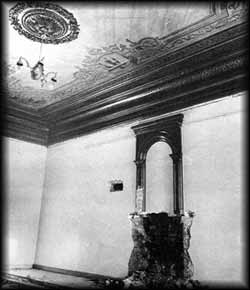
Ipatiev house dining room just before the
house destruction (the fireplace have been removed)
|
Just before
the order execution, some scientific employees from the city museum came
into Ipatiev house during night. They disassembled the fireplace, cut a part
of stairs ladders, removed a door accessories and transferred all this
things to the museum
At end, on September, 16th,
1977, around of the house, a wooden fence was installed and some bulldozers
and other machines started to destroy the house. But it was uneasy – the
house was robust and the destruction took about two days. The first one,
they have taken down the small porch, and for the third day the most part of
the house was on city dumps…
|
Officially, this destruction aimed at improving car traffic in this part of
the city but the real goal of this destruction was to put an end to this
house which symbolized people's interest to the Romanov tragic death. Since
this day, the site of Ipatiev house remained vacant. Although Romanov death
was a very sensitive subject, a lot of people still went there secretly and put
flowers.
It is only in the middle of
90th years it has been decided to restore and
expose the
fireplace in a constant exhibition.
|
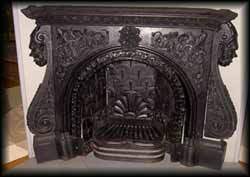
The Ipatiev house dining room fireplace restaured |
|
|
